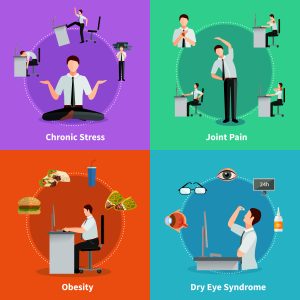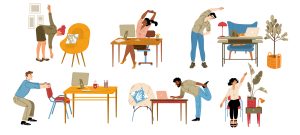医療コラム
The Impact of Prolonged Sitting: Health Risks and Workplace Solutions
Waldemar
Minimal physical activity and prolonged sitting increase the risk of illness. Symptoms like muscle tension or back pain often affect new employees at the beginning of their career. However the long-term consequences are much more serious.
The widespread ailment of back pain is attributed to a lack of movement in 90 percent of cases. Additionally, the risk of developing cancer or depression has been shown to increase with a sedentary lifestyle. At the top of the list of negative effects of physical inactivity are cardiovascular diseases. These can lead to severe long term health complications.
The reason for the harmful effects of sitting is easily explained: Humans are simply not designed to sit still for long periods of time. Our musculoskeletal system, an evolutionary achievement, has scarcely changed since the Stone Age. But unlike us modern humans, our ancestors were constantly on the move as hunters and gatherers.
As some damage cannot be undone after a long life of working, it’s important to consider the effects of too little movement in the workplace:
- Cardiovascular Diseases: Prolonged, almost motionless sitting does not challenge the heart enough. Over time the heart muscle atrophies and starts to get overwhelmed more quickly in physically demanding situations. Since a lack of movement also raises blood pressure, the risks of experiencing a heart attack or a stroke are increased. In this regard, insufficient movement is even more dangerous than the already extremely harmful smoking habit.
- Obesity and Metabolism: Those who engage in minimal physical activity at work burn fewer calories. Gradually, our metabolism gets out of sync. We gain weight and develop metabolic problems like insulin resistance. An especially serious consequence of obesity can be Type 2 diabetes.
- Back Problems: Sustained static sitting encourages the body to adopt an unfavorable position for the back when at rest. The pressure on the intervertebral discs in a curved sitting posture is immense. Additionally, muscles can atrophy and thus may no longer be capable of supporting the spine or correcting posture when necessary. Back pain and herniated discs can occur even at a young age.
- Muscle and Bone Loss: An unfavorable sitting position leads to muscle regression and shortening. This results in tension in the neck and shoulder areas, often causing headaches. Furthermore, the metabolism is slowed down by a lack of movement, which can lead to inadequate nutrient supply all around the body in the long term. The risk of developing arthritis or osteoporosis after the age of 50 increases. Also, office work tends to lead to a lack of Vitamin D, especially in winter. Insufficient Vitamin D intake results in the body’s inability to absorb adequate amounts of calcium. Consequently, this can lead to muscle- and bone-pain.
- Mental Illnesses: No matter what profession, things can sometimes get hectic. During prolonged sitting the body processes stress hormones less effectively. The result is a feeling of chronic stress. In addition to that, insufficient movement in the workplace makes individuals more susceptible to depression.
- Cancer: Prolonged sitting increases the risk of developing colon, lung, or uterine cancer.
- RSI Syndrome (Repetitive Strain Injury): Prolonged stress can cause anatomical damage. If you perform stress inducing movements and activities at high frequency for more than five years (up to 80,000 keyboard keystrokes per day, combined with poor posture), the likelihood of sustained pain is very high. Pain can occur even during rest periods or with minor strains (such as operating the steering wheel of a car, ironing, holding a coffee cup). Typically, the pain is then classified as chronic. The symptoms of RSI syndrome are similar to carpal tunnel syndrome or tendonitis.
- Eye Conditions: Working on a computer is very strenuous for the eyes. Since we blink less, the eyes are not sufficiently moistened with tears. Dry eyes, redness, fatigue, and sometimes even inflammations can occur, such as keratitis (corneal inflammation) or, depending on predisposition, iridocyclitis (inflammation of the iris and ciliary body).
General Tips
Active Commute
By leaving the car in the garage or avoiding the bus and instead walking or cycling to work, you can start your day with a boost of activity.
Midday Walk
It’s important to walk at a pace that does not leave you breathless if you were to hold a conversation meanwhile. The midday walk stimulates circulation and activates your metabolism, strengthens the skeletal muscles, and boosts the immune system. Apart from the refreshing air, exposure to the sun also helps in replenishing some Vitamin D
Ergonomic Office Furniture and Equipment: Chairs, Keyboards, Mouse
Dynamic sitting should not be neglected. It makes sense to sometimes slump into the office chair, slide to the front edge for a short time, stretch and move in general, changing prolonged sitting positions. The key is to break out of rigid postures and keep moving. With constant movement, the body does not fall into unintentional periods of rest and circulation, especially in the legs, remains active.
Fortunately, our team members can choose and order their preferred keyboard and mouse upon starting their employment. Ergonomic chairs are also available in abundance.
Eyes
To counter the strain on the eyes, it helps to regularly look out of the window for a few minutes and focus on distant objects to balance unilateral strain. Rolling the eyes or consciously looking along the contour of an object can also help.
Equally relaxing: Place your palms over your eyes and just gaze into nothingness.
Adequate fluid intake ensures the body’s hydration and reduces dry eyes. Additionally, “artificial tears” ( with hyaluronic acid or sodium hyaluronate) can provide relief.
Water, Tea & Coffee
Fluid Intake: Water and tea contributes to daily fluid intake, which is important to keep the body hydrated.
Antioxidants: Some teas (especially green tea) and coffee contain antioxidants that can potentially provide health benefits, such as supporting the immune system and reducing inflammation.
Soothing Effect: Herbal teas like chamomile or peppermint tea can be calming and stress reducing, positively affecting one’s mindset at work.
Mood Enhancement: Caffeine can elevate mood and reduce stress to a certain extent.
However, it’s important to note that increased caffeine consumption dehydrates the body and can also lead to restlessness, sleep disturbances, or increased tension!
Effect of Music
If easily distracted, music or a quiet corner in the office to block out distracting background noise can help.
Music can elevate the mood, reduce stress, improve concentration, and even increase energy levels. Positive emotions also promote a relaxed work environment.
Of course, a healthy balance should be maintained to avoid damaging one’s ears or disturbing colleagues.
Community and Social Interaction
Spending lunch breaks together can increase the employees’ well-being, foster a sense of community and boost satisfaction. Engaging conversations allow for exchanges on various topics and, ideally, shared laughter. After all, we all know: Laughter is healthy and releases endorphins!
Rest Areas for Resting and also Prayer
Rest areas or retreat options in the workplace can be extremely beneficial for screen-based work, as it provides stress reduction, relaxation, eye relief, mental refreshment and physical relief.
Fortunately, at Eyes Japan, there is a designated area with a couch and a double bed where employees can rest.
Alternatively, everything for prayer can also be arranged there.
Office Exercises
Exercise 1: Neck Twist
A gentle twist of the cervical spine loosens the vertebrae and relieves tension in the neck. Start by gently turning your head to the left and slightly lifting your chin without overextending your head. Then return your head to the center, looking straight ahead and slightly bending your chin toward your chest. Next, turn your head to the right side and repeat all directions several times.
Exercise 2: Shoulder Circles
Circling the shoulders loosens the muscles in the shoulder girdle. It’s important that only the shoulders are involved in the movement while the arms hang loosely. Slightly lift the shoulders – but never up to the ears. Then circle the shoulders forward in a small radius five times and backward several times.
Exercise 3: Chest Lift
The thoracic spine area is also important. First, relax by letting the shoulders drop forward, letting your arms hang alongside your thighs and stretching the thumbs inward. Then create a “heroic chest” by inhaling deeply, letting the shoulders drop backward, slightly raising the chest, and stretching the thumbs outward.
Exercise 4: Back Stretch
Hyperlordosis is a typical posture flaw that affects the lumbar spine. Support it by initially placing your hands behind your back. Now, in the rhythm of your breath, contract the muscles of your abdomen and buttocks while inhaling. Release the tension while exhaling. Repeat this several times to feel the effect.
Exercise 5: Arm Raise
Raise both arms above your head. Keep one arm slightly bent and extend the other upward until you feel a stretch. Perform this exercise alternating between the right and left arm.
Conclusion
The sedentary nature of many jobs poses significant health risks and can contribute to various physical and mental diseases. Prioritizing health and well-being in general not only enhances employee satisfaction but also minimizes the adverse effects of sedentary work lifestyles, promoting a healthier, happier and more productive workforce.
Sources
- (German) Federal Ministry of Health
- Verwaltungs-Berufsgenossenschaft (VBG) – “Administrative Employers’ Liability Insurance Association”
- AOK (German health insurance)
- ChatGPT




 2024/04/23
2024/04/23 2024/03/26
2024/03/26 2024/02/27
2024/02/27 2024/02/23
2024/02/23 2024/02/09
2024/02/09 2024/02/02
2024/02/02 2024/01/23
2024/01/23 2024/01/12
2024/01/12